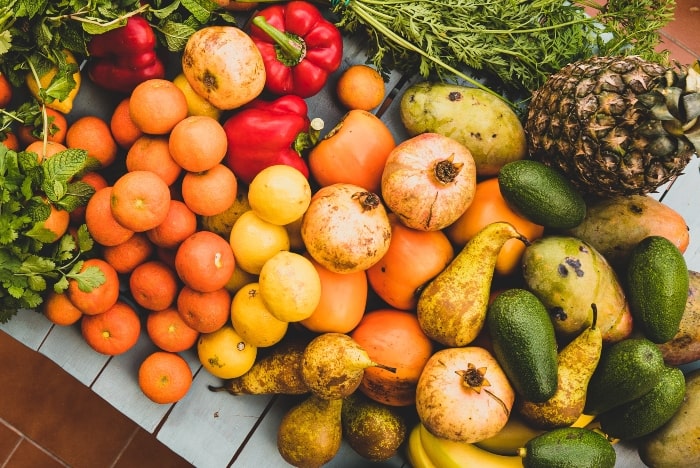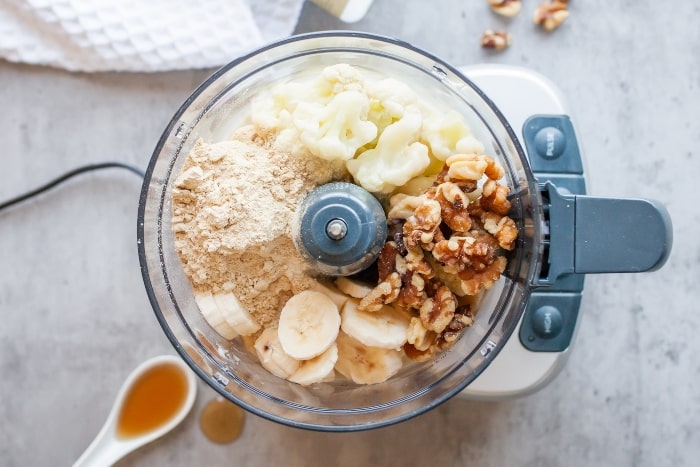Smoothies are a great way to incorporate healthy foods into your daily diet.
Foods high in essential nutrients, fibre, and gut-friendly probiotics, can be packed into your blender to create an extremely healthy and nourishing drink.
But there is one aspect of this process that brings up some important questions…
Blending.
When making a smoothie, does blending destroy nutrients, fibre, or probiotics?
Let’s take a look…
Does Blending Destroy Nutrients?

A smoothie can be an extremely healthy and nutritious drink due to the many nutrient-dense ingredients you can make it with. Popular smoothie ingredients like fruits, vegetables, dairy, nuts, etc. are loaded with nutrients.
Nutrients in food can include macronutrients (carbs, protein, fat), micronutrients (vitamins and minerals), and other biologically active compounds.
The good news is, blending does not destroy nutrients.
In fact, the action of blending, chopping, grinding, and shredding can actually help activate and release many enzymes and bioactive compounds in foods.
Additionally, heating and cooking can deactivate a lot of enzymes in foods. So blending raw fruits and vegetables will actually help you consume these enzymes in their active states.
One way to retain and maximize the nutrients in your blended smoothie, is to keep the peels on your fruits and vegetables. The peel of the fruit/veggie is where nutrients are most concentrated.
While blending does not destroy nutrients, one thing that can affect the nutrient content is oxidation.
Oxidation occurs when certain foods are exposed to oxygen in the air. It is what causes fruits like apples and avocados to turn brown if you cut them and leave them sitting out on the counter.
Oxidation does not necessarily mean the food is going bad; it is more of just an aesthetic change of colour, and perhaps texture and taste of the food as well.
However, oxidation can affect the nutrient content of food over time.
Certain nutrients are sensitive to oxidation and will degrade over time with exposure to oxygen. Vitamin C is an example of this.
Other factors that can degrade nutrients over time are temperature and light exposure.
To prevent degradation of nutrients, it is a good idea to drink your smoothie when it is fresh. The longer you leave it sitting out or stored in the fridge, the more likely it is to gradually lose nutrients over time.
Read more: How Long do Smoothies Last in the Fridge? + How to Store Smoothies
Does Blending Destroy Fibre?
Blended smoothies are a great source of fibre. Smoothie ingredients like fruits and vegetables naturally contain a lot of fibre (both soluble and insoluble).
One of the reasons blending is often preferred as the healthier option over juicing, is because blending does not remove fibre from the ingredients.
Unlike juicing, blending does not extract the juice and discard the pulp of a fruit or vegetable. Discarding the pulp is basically like discarding the fibre of the fruit. Instead, blending incorporates the entire fruit, meaning all the pulp and fibrous material of the fruit remains in your smoothie.
But does this process of blending destroy fibre?
No, blending does not destroy soluble or insoluble fibre.
Fibre is basically undigestible plant material. When we eat something like kale, we chew through the kale as finely as possible with our teeth, then swallow it, and it passes though the digestive system. The fibre in the digested kale does not get absorbed by the body like the rest of the components of the food does (ex: nutrients getting absorbed in the intestines). Instead, it bulks up the stool and encourages bowel movements. Just like chewing the fibrous material does not harm or destroy the fibre, neither does the similar action of blending the fibrous material in a blender.
In order to retain as much fibre as possible in a fruit or vegetable smoothie, simply blend the entire fruit/vegetable without removing the peels or straining out the pulp.
Just like how fruits contain more nutrients in the peel, they also contain more fibre in the peel. Specifically, insoluble fibre. If you peel your fruit, you are removing a lot of the insoluble fibre (although you will still get plenty of soluble fibre from the rest of the fruit).
Does Blending Destroy Probiotics?

Probiotics are beneficial, living bacteria that are found in most fermented foods. These bacteria live in your gut to help with digestion and perform all kinds of other important functions in your body.
Having the right species of bacteria thriving in your gut is actually essential to your overall health. Regular consumption of probiotic-rich foods, such as probiotic smoothies, is a great way to maintain a healthy gut.
Probiotics are found naturally in many smoothie ingredients such as yogurt, kefir, and kombucha.
So, the question is, does blending kill the bacteria in yogurt, kefir, and kombucha?
The answer is no, blending does not destroy probiotics.
When you think about it, probiotic bacteria are way too small to be harmed by blending…or chewing for that matter!
One thing that can harm probiotic bacteria however, is heat. Many bacteria species will die when exposed to temperatures above ~115-130 degrees Fahrenheit. Again, this is where blending ingredients as they are, can actually help you maximize those health benefits.
Conclusion
That’s it for this post! I hope this cleared up whether or not blending destroys nutrients, fibre, or probiotics.
Now you can have peace of mind knowing your blended smoothie contains all the nutritional benefits the ingredients can offer!


Thank you for this post👍🏾
You’re welcome! Glad you liked it 🙂